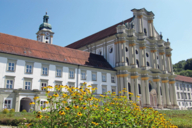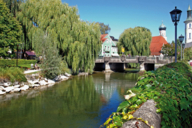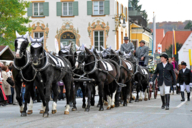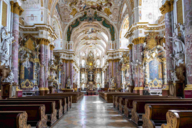
Fürstenfeldbruck is known for its magnificent Late Baroque “cloister of atonement” monastery and the influential Miller family who lived there. In 1850, Ferdinand von Miller created the statue of Bavaria which presides over Munich’s Oktoberfest grounds. His son Oskar was later responsible for Fürstenfeldbruck becoming one of the first Bavarian municipalities to be connected to the electricity network, and he also founded the Deutsches Museum in Munich in 1903.
- Fürstenfeldbruck and its history
- Sights in Fürstenfeldbruck
- Kloster Fürstenfeld (abbey)
- Fürstenfeldbruck: How to get there from Munich
Home to some 38,000 residents, the large district town of Fürstenfeldbruck is located around 30 kilometres west of Munich. It takes its name from the monastery of Fürstenfeld put together with the medieval district of Bruck, which is a hundred years or so older than the monastery.
The settlement originally sprang up close to the Amperbrücke (bridge), which has always been the site of a river crossing; today’s visitors come to queue for the ice cream parlour or sun themselves on a bench by the river. Opposite the bridge every Oktober, horses are blessed in front of the Leonhardikirche (church), as part of the traditional Leonhardifahrt horseback procession marking the feast day of St Leonard.
The river crossing was a key customs post in the Middle Ages, sited as it was on the trading route between Munich market which was founded in 1158, and the ancient Roman metropolis of Augsburg. Innkeepers, butchers, beer brewers and blacksmiths set up home along what is now the main street of the town. In 1306 Bruck was granted the right to hold its own markets, and to this day, the town’s historic Altstadt district is characterised by numerous restaurants, former breweries and the market Sundays which take place in spring and autumn.
On the main street the “Brameshuber Ensemble” can be found: a pair of listed houses painted in confectioner's colours. It was in the smaller of the two, on the right-hand side, that the metal caster Ferdinand von Miller was born in 1813. As arguably the most famous of Fürstenfeldbruck’s citizens, he is commemorated with a plaque on the wall of the house and a sculpture which includes a casting of a fingertip from his famous Bavaria statue.

The 16-metre-tall female figure which he created, and which stands on Munich’s Theresienwiese (Oktoberfest fairground), is the world’s largest colossal statue made entirely from cast bronze. The Ferdinand von Miller connection reaches all the way to the new world too, as the gate of the Capitol building in Washington and a statue of George Washington in Richmond were both cast by him. King Maximilian II elevated him to the peerage in recognition of his accomplishments.
His youngest son, Oskar von Miller, was not only the founder of the Deutsches Museum in Munich, but he also pioneered the introduction of electricity in Bavaria. Under his direction, Bavaria’s first municipal electricity plant began operations in Schöngeising near Fürstenfeldbruck in 1892 – and the heritage-listed hydroelectric power station is still in operation today.

There is a footpath which goes through the green areas along the Amper river, leading you from the city centre to the former Fürstenfeld Abbey. The monastery was established by the Wittelsbach duke Ludwig II in 1263, as an atonement for the execution of his wife, Maria von Brabant: he accused her of adultery in 1256 and had her beheaded, though he subsequently recognised that the accusations were unfounded and she was in fact innocent. For this gruesome deed, the duke became known as “der Strenge” (the Strict).
His son, Ludwig IV the Bavarian, who would eventually attain the status of Holy Roman Emperor, supported the monastery generously. According to legend he was killed in an accident in 1347, while hunting bear in the forest near Fürstenfeldbruck; the Kaiser-Ludwig-Säule obelisk still stands in his memory at the spot on which he died in the district of Puch.
As the 17th century drew to a close, plans to expand Fürstenfeld Abbey into a castle and burial grounds for the Wittelsbach family were drawn up. The works were largely modelled on the monastery of El Escorial near Madrid, and Elector Max Emanuel commissioned the most prominent Bavarian Late Baroque artists with the construction and outfitting of the buildings.

Italian master builder Giovanni Antonio Viscardi was entrusted with the overall planning of the project. The Asam family of artists devised large portions of the interior design and painted splendid frescoes for the monastery church. The church interior still makes a breathtaking impression on everyone who enters.
The Fürstenfeld monastery was dissolved in 1803 with the secularisation of imperial estates of the Holy Roman Empire. The Museum Fürstenfeldbruck has found its exhibition rooms in the former monastery buildings. The Fürstenfeld Events Forum is located in an architecturally very interesting extension. With theatre, concerts, cinema and arts and crafts, it attracts around 300,000 visitors a year. Visitors can look forward not only to experiencing the magnificent church architecture and culture there though, as they can also treat themselves to coffee and cake or a cool beer in the beer garden or one of the restaurants located in the cloister courtyards.
Regional railway or S-Bahn (S4) from Munich: approx. 15 - 25 minutes. Information at bahn.de
Car: approx. 50 minutes via the A99 motorway